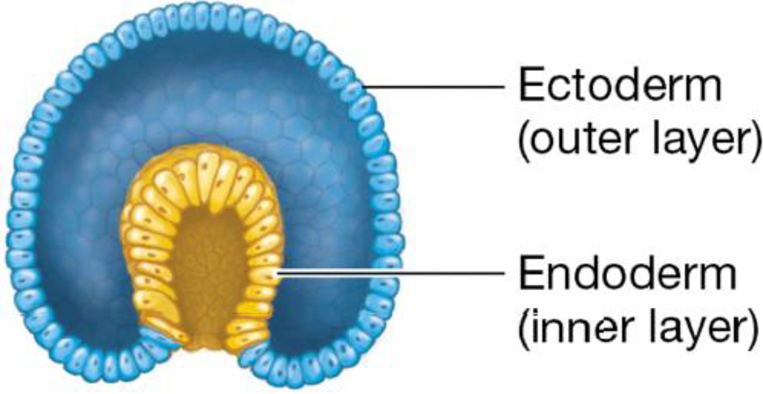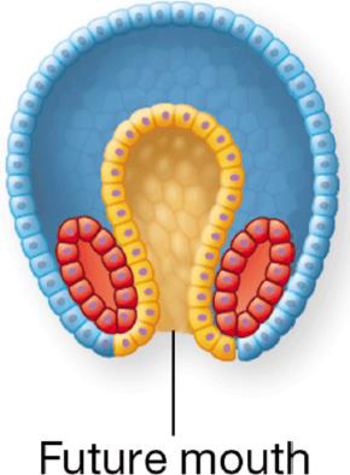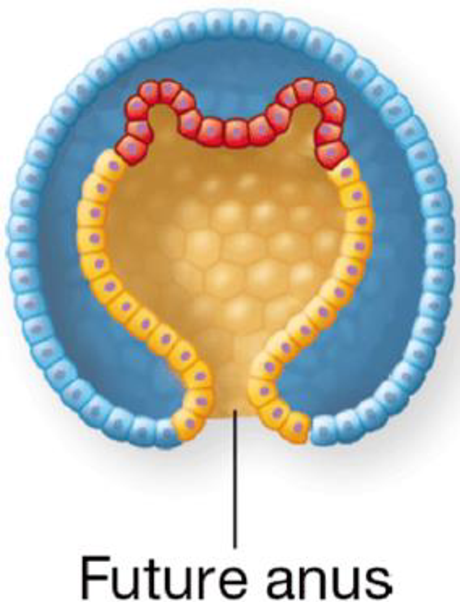
CAMP.BIO:CONC...MOD.MAST+PRINT>I<
10th Edition
ISBN: 9780136858287
Author: Taylor
Publisher: INTER PEAR
expand_more
expand_more
format_list_bulleted
Textbook Question
Chapter 18, Problem 2CC
Identify the pattern of embryonic development shown in each drawing below and name the phylum (or phyla) that exhibit this pattern.
a. 
b. 
c. 
Expert Solution & Answer
Want to see the full answer?
Check out a sample textbook solution
Students have asked these similar questions
Study the sea star development slides, including early and late stages and identify the following
stages and structures: zygote, two cell stage, morula (stage), blastula (stage), blastocoel
(cavity), archenteron (cavity), ectoderm (layer), endoderm (layer), gastrula (stage).
**See Table 52.1, Section 52.3 & 52.4 in textbook **
Why is it useful to study the development of sea stars (Echinodermata) when studying
human development? What do the two have in common?
Give the name of the structure that the phrase describes. The structure that is formed after the morula stage
Consider the variation in reproductive systems within the animal kingdom. These are discussed in the textbook readings. Select 1 or 2 traits and compare and contrast the human situation with other members of the animals kingdom. Two examples of traits are sexual reproduction and menopause.
Part B
Describe the development of the human embryo from the formation of the zygote to the point where the three embryonic germ layers develop. List the types of adult tissues that are derived from each of these germ layers. Be prepared to discuss how disruption early in development can cause major problems in the body of the developing individual.
Chapter 18 Solutions
CAMP.BIO:CONC...MOD.MAST+PRINT>I<
Ch. 18 - Prob. 1CCCh. 18 - Identify the pattern of embryonic development...Ch. 18 - Bilateral symmetry in animals is best correlated...Ch. 18 - Jon found an organism in a pond, and he thinks its...Ch. 18 - Which of the following groupings includes the...Ch. 18 - Which of the following animal groups does not have...Ch. 18 - Prob. 7TYKCh. 18 - Prob. 8TYKCh. 18 - Prob. 9TYKCh. 18 - Prob. 10TYK
Ch. 18 - The simplest animal group a. annelids b. nematodes...Ch. 18 - Prob. 12TYKCh. 18 - Largest phylum of all a. annelids b. nematodes c....Ch. 18 - Closest relatives of chordates a. annelids b....Ch. 18 - Prob. 15TYKCh. 18 - Prob. 16TYKCh. 18 - Prob. 17TYKCh. 18 - Name two phyla of animals that are radially...Ch. 18 - One of the key characteristics of arthropods is...Ch. 18 - A marine biologist has dredged up an unknown...Ch. 18 - SCIENTIFIC THINKING In one of the experiments...
Knowledge Booster
Learn more about
Need a deep-dive on the concept behind this application? Look no further. Learn more about this topic, biology and related others by exploring similar questions and additional content below.Similar questions
- Give typing answer with explanation and conclusionarrow_forwardMake a table to identify amle and female homologues and describe it common function. Minimum of 7 organs.arrow_forwardD. Discuss the development interaction between the actoderm and the mesoderm in the evolution of the Deuterostomes. E. Discuss the significant changes that are represented in the evolution of the prokaryote cell type into the eukaryote cell. What these changes accomplish?arrow_forward
- Explain the development of human embryo with diagrams.arrow_forwardAt which stage of embryonic development does the embryo have a blastopore? Group of answer choices A.Blastula B. Zygote C. Morula D. Gastrulaarrow_forwardC. Evidence from embryology Embryology is the study of the development of an organism from an embryo to its adult form. Common structures are shared in the embryo stage and disappear by the time the embryo reaches the juvenile or adult form. Observe the illustration below of the different stages of embryo from different organisms and hypothesize which embryo is from each of the organisms. Write the letter in the following table under the "Embryo category". Then describe how the embryos changed for each of these organisms from their earliest to latest stages. 59 9383 Early stage Late stagearrow_forward
- profile-image For which organism and life stage would you expect to see the most rapid senescence? A.) A long-lived organism that has not yet reached sexual maturity. B.) A semelparous organism with parental care that has completed reproduction. C.) An iteroparous organism that has completed its first breeding season. D.) A semelparous organism without parental care that has completed reproduction.arrow_forwardThe development of a zygote into a baby involves pre-embryonic development for the first 2 weeks, followed by embryonic development for the next 6 weeks, and finally fetal development until the baby is born. When is the developing baby considered a fetus? Select one: a. When all major organ systems have formed b. After the neural tube forms c. Once gastrulation is complete d. When most major organ systems have formed; the neural system forms during the fetal stagearrow_forwardExplain the following terms: ectoderm, endoderm, mesoderm and stem.arrow_forward
- A human is a complex organism that develops from a zygote. Briefly explain some of the the steps in this development process in the form of a paragraph. In your answer, be sure to: 1) explain how a zygote formed, 2) compare the genetic content of the zygote to the body cells of the parents, 3) identify the structure in which embryonic/fetal development usually occurs within, and 4) identify the structure that forms, which provides nourishment and waste removal to/from the developing baby.arrow_forwardWhich of the following statements about gastrulation is correct? A. During gastrulation, the contents of cell nuclei begin to vary so that they can start to perform different fucntions. B. During gastrulation, cells differentiate so that they can start to perform different functions. C. The formation of the endoderm, mesoderm, and ectoderm occurs after gastrulation. D. The formation of the endoderm, mesoderm, and ectoderm occurs before gastrulation.arrow_forwardWhat might a developmental anatomist study? A. Differences in athletes training at age 18 and age 50. B. How the body decays after death C. The body’s reaction to cold temperature D. How genetic code is passed down through generationsarrow_forward
arrow_back_ios
SEE MORE QUESTIONS
arrow_forward_ios
Recommended textbooks for you
 Human Biology (MindTap Course List)BiologyISBN:9781305112100Author:Cecie Starr, Beverly McMillanPublisher:Cengage Learning
Human Biology (MindTap Course List)BiologyISBN:9781305112100Author:Cecie Starr, Beverly McMillanPublisher:Cengage Learning

Human Biology (MindTap Course List)
Biology
ISBN:9781305112100
Author:Cecie Starr, Beverly McMillan
Publisher:Cengage Learning
Embryology | Fertilization, Cleavage, Blastulation; Author: Ninja Nerd;https://www.youtube.com/watch?v=8-KF0rnhKTU;License: Standard YouTube License, CC-BY